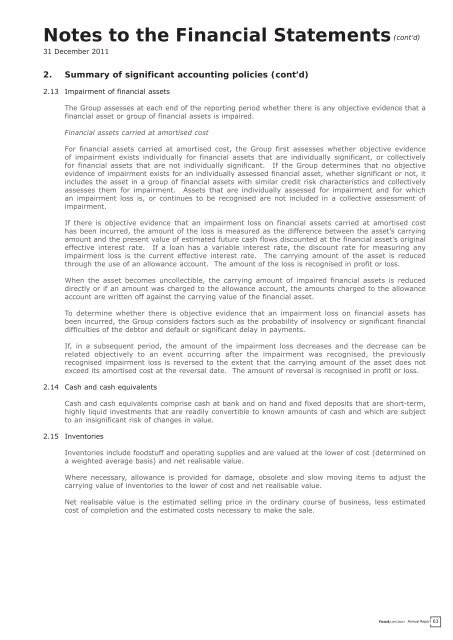Annual Report 2011 - Food Junction
Annual Report 2011 - Food Junction
Annual Report 2011 - Food Junction
Create successful ePaper yourself
Turn your PDF publications into a flip-book with our unique Google optimized e-Paper software.
Notes to the Financial Statements (cont’d)<br />
31 December <strong>2011</strong><br />
2. Summary of significant accounting policies (cont’d)<br />
2.13 Impairment of financial assets<br />
The Group assesses at each end of the reporting period whether there is any objective evidence that a<br />
financial asset or group of financial assets is impaired.<br />
Financial assets carried at amortised cost<br />
For financial assets carried at amortised cost, the Group first assesses whether objective evidence<br />
of impairment exists individually for financial assets that are individually significant, or collectively<br />
for financial assets that are not individually significant. If the Group determines that no objective<br />
evidence of impairment exists for an individually assessed financial asset, whether significant or not, it<br />
includes the asset in a group of financial assets with similar credit risk characteristics and collectively<br />
assesses them for impairment. Assets that are individually assessed for impairment and for which<br />
an impairment loss is, or continues to be recognised are not included in a collective assessment of<br />
impairment.<br />
If there is objective evidence that an impairment loss on financial assets carried at amortised cost<br />
has been incurred, the amount of the loss is measured as the difference between the asset’s carrying<br />
amount and the present value of estimated future cash flows discounted at the financial asset’s original<br />
effective interest rate. If a loan has a variable interest rate, the discount rate for measuring any<br />
impairment loss is the current effective interest rate. The carrying amount of the asset is reduced<br />
through the use of an allowance account. The amount of the loss is recognised in profit or loss.<br />
When the asset becomes uncollectible, the carrying amount of impaired financial assets is reduced<br />
directly or if an amount was charged to the allowance account, the amounts charged to the allowance<br />
account are written off against the carrying value of the financial asset.<br />
To determine whether there is objective evidence that an impairment loss on financial assets has<br />
been incurred, the Group considers factors such as the probability of insolvency or significant financial<br />
difficulties of the debtor and default or significant delay in payments.<br />
If, in a subsequent period, the amount of the impairment loss decreases and the decrease can be<br />
related objectively to an event occurring after the impairment was recognised, the previously<br />
recognised impairment loss is reversed to the extent that the carrying amount of the asset does not<br />
exceed its amortised cost at the reversal date. The amount of reversal is recognised in profit or loss.<br />
2.14 Cash and cash equivalents<br />
Cash and cash equivalents comprise cash at bank and on hand and fixed deposits that are short-term,<br />
highly liquid investments that are readily convertible to known amounts of cash and which are subject<br />
to an insignificant risk of changes in value.<br />
2.15 Inventories<br />
Inventories include foodstuff and operating supplies and are valued at the lower of cost (determined on<br />
a weighted average basis) and net realisable value.<br />
Where necessary, allowance is provided for damage, obsolete and slow moving items to adjust the<br />
carrying value of inventories to the lower of cost and net realisable value.<br />
Net realisable value is the estimated selling price in the ordinary course of business, less estimated<br />
cost of completion and the estimated costs necessary to make the sale.<br />
<strong>Annual</strong> <strong>Report</strong> 63


